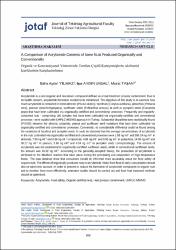| dc.contributor.author | Yılmaz, Baha Aydin | |
| dc.contributor.author | Ünsal, Işin Aydın | |
| dc.contributor.author | Taşan, Murat | |
| dc.date.accessioned | 2023-05-06T17:23:39Z | |
| dc.date.available | 2023-05-06T17:23:39Z | |
| dc.date.issued | 2023 | |
| dc.identifier.issn | 1302-7050 | |
| dc.identifier.issn | 2146-5894 | |
| dc.identifier.uri | https://doi.org/10.33462/jotaf.1128261 | |
| dc.identifier.uri | https://hdl.handle.net/20.500.11776/12228 | |
| dc.description.abstract | Acrylamide is a carcinogenic and neurotoxic compound defined as a heat treatment process contaminant. Due to its health concern, acrylamide formation needed to be minimized. The objective of this study is to examine how much acrylamide is contained in dried almonds (Prunus dulcis), hazelnuts (Corylus avellana), pistachios (Pistacia vera), peanuts (Arachishypogaea), sunflower seeds (Helianthus annuus) as well as pumpkin seeds (Cucurbita pepo) that have been cultivated via organically-certified and conventional processes. Frequently and regularlyconsumed nuts - comprising 180 samples that have been cultivated via organically-certified and conventional processes - were studied with UHPLC-MS/MS approach in Turkey. Substantial disparities were statistically found (P<0.05) between the almond, pistachio, peanut and sunflower seed variations that have been cultivated via organically-certified and conventional processes. Conversely, no considerable difference could be found among the variations of hazelnut and pumpkin seeds. It could be observed that the average concentrations of acrylamide in the nuts cultivated via organically-certified and conventional processes were 1.68 ng ml(-1) and 266.14 ng ml(-1) in almonds, 7.90 ng ml-1 and 6.68 ng ml(-1) in hazelnuts, 4.86 ng ml(-1) and 9.95 ng ml(-1) in pistachios, 14.09 ng ml(-1) and 36.27 ng ml(-1) in peanuts, 5.96 ng ml(-1) and 4.54 ng ml(-1) in pumpkin seeds correspondingly. The amount of acrylamide was not ascertained in organically-certified sunflower seeds, while in conventional sunflower seeds, the amount was 16.92 ng ml(-1). According to the generally-accepted theory, the production of acrylamide is attributed to the Maillard reaction that takes place during the processing and preparation of high-temperature foods. The data obtained show that consumers should be informed more accurately about the food safety of organic nuts. The effects of organically produced nuts on acrylamide intake from food in daily consumption should also be taken into account. In order to prevent or reduce the formation of acrylamide compounds in organic nuts and to monitor them more effectively, extensive studies should be carried out and food heat treatment methods should be optimized. | en_US |
| dc.language.iso | eng | en_US |
| dc.publisher | Univ Namik Kemal | en_US |
| dc.identifier.doi | 10.33462/jotaf.1128261 | |
| dc.rights | info:eu-repo/semantics/openAccess | en_US |
| dc.subject | Acrylamide | en_US |
| dc.subject | Food safety | en_US |
| dc.subject | Organic certified nuts | en_US |
| dc.subject | Heat process contaminant | en_US |
| dc.subject | UHPLC-MS/MS | en_US |
| dc.subject | Foods | en_US |
| dc.subject | Antioxidants | en_US |
| dc.title | A Comparison of Acrylamide Contents of Some Nuts Produced Organically and Conventionally | en_US |
| dc.type | article | en_US |
| dc.relation.ispartof | Journal Of Tekirdag Agriculture Faculty-Tekirdag Ziraat Fakultesi Dergisi | en_US |
| dc.department | Fakülteler, Ziraat Fakültesi, Gıda Mühendisliği Bölümü | en_US |
| dc.identifier.volume | 20 | en_US |
| dc.identifier.issue | 1 | en_US |
| dc.identifier.startpage | 166 | en_US |
| dc.identifier.endpage | 174 | en_US |
| dc.institutionauthor | Yılmaz, Baha Aydin | |
| dc.institutionauthor | Ünsal, Işin Aydın | |
| dc.institutionauthor | Taşan, Murat | |
| dc.relation.publicationcategory | Makale - Uluslararası Hakemli Dergi - Kurum Öğretim Elemanı | en_US |
| dc.identifier.wos | WOS:000925798200016 | en_US |
| dc.identifier.scopus | 2-s2.0-85146936581 | en_US |
| dc.identifier.trdizinid | 1153419 | en_US |



















